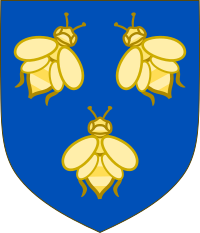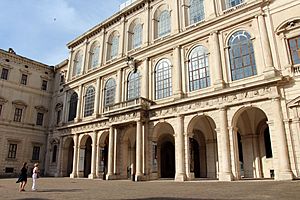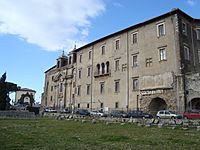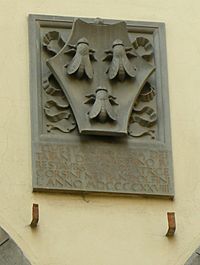Barberini family facts for kids
| Barberini |
|||
|---|---|---|---|
Quick facts for kids  Barberini coat of arms. |
|||
| Country: | Italy | ||
| Titles: | * Pope (non-hereditary)
|
||
| Founder: | Antonio Barberini (1494–1559) | ||
| Current Head: | Benedetto Francesco Barberini, Prince of Palestrina (born 1961) | ||
| Founding Year: | Between 1530 and 1559 | ||
| Cadet Branches: | * House of Colonna di Sciarra
(By marriage of female heirs – male line became extinct twice. ) |
||
The House of Barberini was a powerful and important family in Italy. They became very famous in the 1600s, especially in Rome. Their biggest moment was when one of their family members, Cardinal Maffeo Barberini, became Pope Urban VIII in 1623.
The Barberini family built a grand home in Rome called the Palazzo Barberini. It was finished in 1633 by a famous artist named Gian Lorenzo Bernini. Today, this palace is a museum called the Galleria Nazionale d'Arte Antica, which means "National Gallery of Ancient Art."
Contents
How the Barberini Family Started
The Barberini family first came from a small town in Tuscany, Italy, called Barberino Val d'Elsa. They moved to Florence in the early 11th century.
Two brothers, Carlo (born 1488) and Antonio Barberini (born 1494), were successful merchants. They traded in grain, wool, and textiles in Florence. In 1530, Antonio helped defend the Florentine Republic. But after the city was taken over by new rulers, the Medici family, Antonio decided to leave. In 1537, he moved to Rome to manage the family's business there.
In 1552, Carlo's son, Francesco, joined his uncle Antonio in Rome. Their business grew a lot. Francesco became very rich and bought important positions in the government and the Catholic church. In 1559, his uncle Antonio died due to conflicts with the Medici family.
Francesco kept building his wealth and titles until he passed away in 1600. Usually, his family would have faced problems because he ran a business while holding a church office. But his relatives successfully appealed to the church leaders. This allowed the Barberini family business to continue, with Francesco's nephews taking over, including Maffeo Barberini.
Pope Urban VIII: A Barberini Pope

The Barberini family became incredibly wealthy and powerful when Cardinal Maffeo Barberini was chosen as Pope in 1623. He took the name Pope Urban VIII. He quickly gave important jobs to his family members.
He made his brother, Antonio, and two nephews, Francesco and Antonio Barberini, cardinals (high-ranking church officials). He also made another brother the Duke of Monterotondo. A third nephew, Taddeo Barberini, was given control of the area around Palestrina. Taddeo also became the Pope's flag-bearer, the leader of Rome, and the commander of Castel Sant'Angelo.
Pope Urban VIII's time as Pope was known for his achievements in church matters and culture. However, he also gave many important jobs and titles to his family members. This practice is called nepotism. One writer at the time said that when Urban became Pope, his relatives "flew from Florence to Rome like so many bees (which are the Barberini's arms), to suck the honey of the Church."
Towards the end of Urban's time as Pope, a conflict called the War of Castro also made him and his family less popular. It's thought that during his rule, the Barberini family gained a huge amount of wealth, about 105 million scudi (an old Italian currency).
Pope Urban VIII also used ancient bronze from the Pantheon (an old Roman temple) to make parts for the altar canopy in St. Peter's Basilica and for cannons. This led to a famous saying: "What the barbarians did not do, the Barberini did." This meant that even invaders hadn't damaged the Pantheon as much as the Barberini did by taking its bronze.
Conflicts, Exile, and Return
The Barberini family was deeply involved in the First War of Castro. This war started when another powerful noble, Odoardo Farnese, insulted the Pope's nephews. The war didn't have a clear winner, and Pope Urban VIII died in 1644, shortly after a peace agreement was signed.
Even though Urban had made many of his relatives cardinals, the group of cardinals chose a new Pope, Pope Innocent X, from the Pamphili family. Immediately, Pope Innocent X started looking into what the Barberini family had done during the war.
The three nephews who had become very powerful under Pope Urban VIII – Cardinals Antonio and Francesco, and Prince Taddeo – were forced to leave Rome. They went to Paris for protection from a powerful French cardinal. Antonio and Taddeo left first, putting the French symbol above their palace door to show they were under France's protection. Francesco joined them later.
Taddeo's wife, Anna Colonna, also went to Paris. But first, she bravely asked the new Pope not to take away the Barberini family's wealth. The Pope agreed. He used some of their money to pay debts but left the rest of their fortune alone.
The family stayed in Paris until 1653, when most of them returned to Rome. Taddeo died in exile in 1647. However, his brothers eventually made peace with the Pope. This happened when Taddeo's younger son, Maffeo, married Olimpia Giustiniani, who was a niece of Pope Innocent X. Maffeo then received his father's old title, Prince of Palestrina.
Taddeo's older son, Carlo Barberini, was made a cardinal by Pope Innocent X. Taddeo's daughter, Lucrezia Barberini, married a powerful Duke who had been on the other side during the war. This marriage helped to make relations even better between the families.
Later Barberini History
In 1627, Taddeo Barberini married Anna Colonna. This marriage began a long process that eventually led to the Barberini family joining with the Colonna family.
In 1728, a branch of the Colonna family added the Barberini name to theirs. This happened when Giulio Cesare Colonna di Sciarra married Cornelia Barberini. Cornelia was the daughter of Urbano Barberini (1664–1722), who was the last male heir of the Barberini family born in marriage.
Even though Urbano didn't have any sons born in marriage, he did have a son named Maffeo Callisto Barberini in 1688. Urbano's last wife mentioned this son in her will and left him a large part of the Barberini family's wealth.
Later, Maffeo Callisto's descendants and the Colonna family branch had a disagreement over who should inherit the Barberini wealth. But they settled their dispute in Paris in 1811, dividing the wealth between the two family branches.
The Colonna line of the family eventually ended when Prince Enrico Barberini-Colonna died. His daughter, Maria, inherited the name. Her husband, Marquis Luigi Sacchetti, was given the title of Prince of Palestrina and permission to use the Barberini name.
On June 21, 2005, Augusto Barberini, the 13th Prince of Palestrina, passed away in Rome. The current head of the family is Benedetto Francesco Barberini, Prince of Palestrina, who was born in 1961. His oldest son is his heir.
Supporters of the Arts
The Barberini family loved and supported art. The Palazzo Barberini, their huge library (now part of the Vatican Library), and many buildings, altars, and other projects across Rome show how rich and artistic they were in the 1600s. You can often see their family symbol, the three bees, on these projects.
The family hired many artists, like Lorenzo Ottoni, for their projects. They were also important early supporters of opera. They paid famous singers, like Marc'Antonio Pasqualini, and even built their own private opera house, the Teatro delle Quattro Fontane. Many artworks that once belonged to the Barberini family are now in museums around the world, including:
- The Barberini Faun and Barberini Apollo, which are now in a museum in Munich, Germany.
- The Barberini Venus.
- The Barberini Hera.
- The Portland Vase (once called the Barberini Vase), which is now in the British Museum.
- The Allegory of Divine Providence and Barberini Power, a famous painting.
- The Anglo-Saxon Barberini Gospels, an old book in the Vatican Library.
- The Barberini Codex, an Aztec herbal manuscript, now back in Mexico.
Some art pieces are still owned by the family, and many are in the Galleria Nazionale d'Arte Antica at the Palazzo Barberini in Rome. The Barberini family had a huge impact on culture. A big international meeting was even held in 2004 about "The Barberini and European Culture."
Barberini Family Tree
This is a family tree of the Barberini family from the 1500s and 1600s. The colored squares show the main line of the family.
| Carlo Barberini (born 1488) |
Cassandra del Branca | Antonio Barberini (born 1494) |
|||||||||||||||||||||||||||||||||||||||||||||||||||||||||||||||||||
| Francesco Barberini | Antonio Barberini | Camilla Barbadori | |||||||||||||||||||||||||||||||||||||||||||||||||||||||||||||||||||
| Carlo Barberini | Costanza Magalotti | Alessandro Barberini | Niccolo Barberini | Pope Urban VIII | Antonio Marcello Barberini | ||||||||||||||||||||||||||||||||||||||||||||||||||||||||||||||||
| Francesco Barberini (senior) | Camilla Barberini | Maria Barberini | Taddeo Barberini | Anna Colonna | Clarice Barberini | Antonio Barberini | |||||||||||||||||||||||||||||||||||||||||||||||||||||||||||||||
| Francesco I d'Este | Lucrezia Barberini | Carlo Barberini | Maffeo Barberini | Olimpia Giustiniani (Pamphili) | |||||||||||||||||||||||||||||||||||||||||||||||||||||||||||||||||
| Rinaldo d'Este | Costanza Barberini | Camilla Barberini | Francesco Barberini (junior) | Urbano Barberini (1664–1722) | Taddeo Barberini | ||||||||||||||||||||||||||||||||||||||||||||||||||||||||||||||||
See also
 In Spanish: Barberini para niños
In Spanish: Barberini para niños
- The Allegory of Divine Providence and Barberini Power
- Ferrante Pallavicino – a writer who made fun of the Barberini family.





